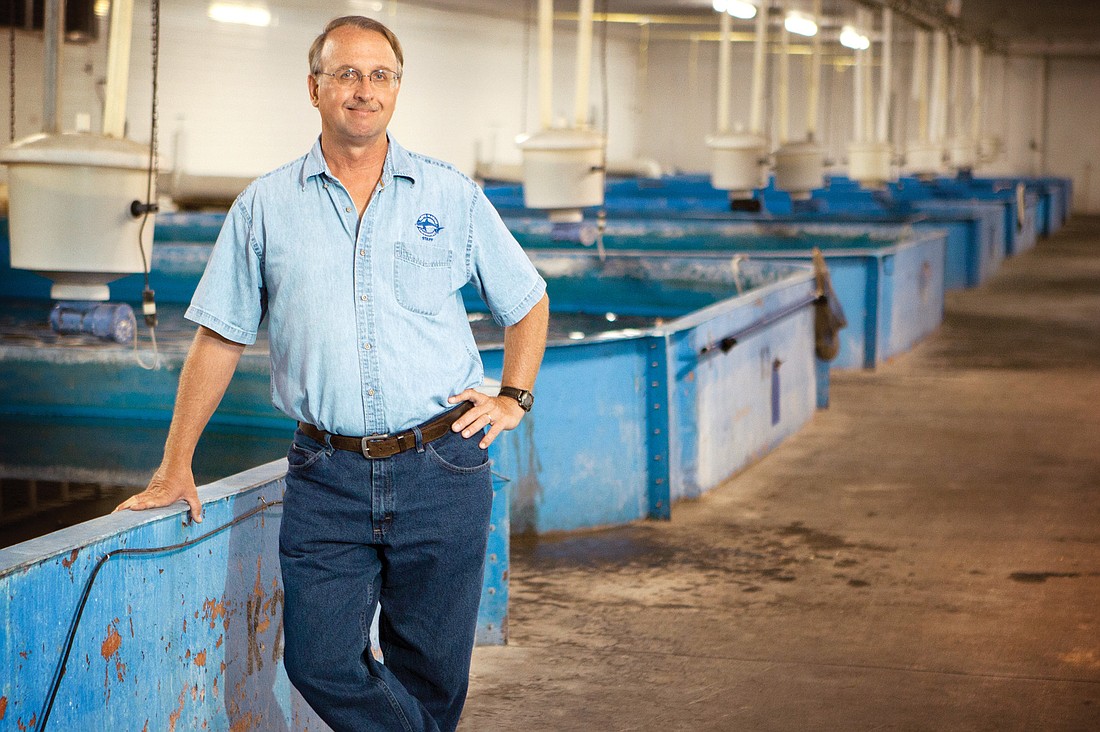- April 23, 2024
-
-
Loading

Loading

The plan was largely on target until a sweltering summer night almost derailed it.
That night was July 20, when the nonprofit Mote Marine Aquarium, was struck by what could be any organization’s worst nightmare: a fire.
In Mote’s case, the fire, for which the cause was never determined, destroyed one building at its Mote Aquaculture Park off Fruitville Road, seven miles east of I-75. That lone 25,000-square-foot building, though, represented eight years and more than $3 million in work toward Mote’s caviar goal. The building housed 16 separate 19,000-gallon fiberglass tanks, plus filtration and feeding systems. It also housed about one-third of Mote’s total caviar-producing sturgeon stock.
“That was a very tough time,” says Jim Michaels, the director of the Sturgeon Aquaculture Program at Mote, who wrote the business plan in 2002. “It was a huge loss. It’s not like making widgets, where you can always put more on the shelf. We almost had to restart. We had to push the go button again.”
But the do-over was nearly spoiled two years later, when the recession slashed the value of caviar — salted eggs of sturgeon fish sometimes called black gold — worldwide by at least 50%. Michaels and his team persevered, however, and now he projects 2013 could be the year the program reports its first profit. “We are getting close,” says Michaels, a onetime NASA employee, “but we are not there yet.”
Mote Marine Laboratory, founded in 1955, had $18.2 million in revenues in fiscal year 2011 against $19.7 million in expenses, according to the nonprofit tax return forms it files with the Internal Revenue Service. About 7% of Mote’s annual budget, or $1.3 million, comes from Mote’s sturgeon and caviar program, the organization says. The program, adds Nadine Slimak, the laboratory’s communications director, is about 80% self-sustaining. Grants and donations cover the rest.
The Mote program, moreover, represents some unique firsts in both national marine technology and local manufacturing.
On the latter, the Mote Aquaculture Park is certainly an unusual find: It’s a full-fledged Siberian sturgeon caviar and meat-production facility. It has nine employees, and it partners with seafood wholesale companies and caviar houses that sell the final product to select grocery chains, restaurants and resorts. Some of the Mote caviar retails for $55 an ounce.
The aquaculture park where the caviar is made is a sprawling assortment of tan-and-brown-colored hangars. The structures, built in 1998 on what was pastureland, house the tanks, labs and offices.
The manufacturing includes harvesting eggs, managing a highly regulated ultra-clean environment and maintaining a precision packaging system. Mote’s finely tuned and precision-timed caviar manufacturing process, further, was featured in April, on the TV show “How It’s Made” on the Science Channel.
Says Michaels: “We are doing some really neat work here.”
The technology side, meanwhile, is no less neat. The park, overall, is one of the largest recirculating aquaculture research facilities in the U.S. The overarching goal of the program, Mote executives say, is to prove that unlimited water access isn’t necessary for large-scale food fish-and-shellfish production.
“We aren’t trying to corner the market in terms of production of caviar,” Michaels says. “Our goal is to push the envelope on this kind of technology.”
Four corners
The push was close to a pull in another direction.
That goes back to the 2006 fire, when Mote executives and board members had to make a tough call. The organization considered shutting down the program. But Slimak says Mote ultimately decided to carry on, despite the added expense of rebuilding. That effort took more than $1 million.
“One of our key goals at Mote Aquaculture Park is to develop land-based alternatives for fish farming that don’t harm the environment,” Slimak said in an email to the Business Observer. “At the farm, we are developing new technologies and methods that focus on maximizing water resources.”
Mote launched its caviar and aquaculture program in 1998. It chose sturgeon, one of the oldest and rarest freshwater fish in the world, because that species goes through cycles of overfishing. Mote executives believed their aquaculture park could alleviate some of that pressure.
Michaels, with a master’s degree in oceanography from Old Dominion University, in Virginia, was hired in 2002. He previously worked for commercial-fish operations in California, and in the 1980s, he was part of a group of pioneering scientists who worked on growing tilapia.
Michaels says he was attracted to Mote because the organization was serious about advancing the field.
“They were willing to take an economic risk,” he says, “which is really amazing for a nonprofit research lab.”
Mote sold its first batch of caviar in 2006. Today it sells both sturgeon meat and caviar. The high-end caviar can be found in a variety of Sarasota-Bradenton eateries, in addition to Whole Foods, Costco and Dean & Deluca stores. Michaels adds that Mote caviar is sold in all four corners of the U.S.: Miami, Seattle, Los Angeles and in Maine.
Michaels says another key factor behind the lab’s progress, besides perseverance, has been its pursuit for the best-tasting caviar on the market. It’s a combination of art and science that includes several intricate steps.
“The devil is in the details,” says Michaels. “We strive to make a quality product. We strive for perfection.”